How to Protect Your Invention - The Non-Disclosure Agreement (NDA) - Confidentiality Agreement

Keeping your invention or business idea secret is an important part of protecting your intellectual property rights. Publicly disclosing information about your invention or business idea can result in a loss of patent rights, a loss of a competitive advantage and potentially a loss of any time or money you invested in the new idea. But it's usually necessary to discuss your invention with other people in order to develop and commercialize the invention. Of course, the more people you share your idea with, the greater chance that details about invention will be leaked to the general public. It's even possible that someone, perhaps a potential competitor, might even try to copy or misappropriate your idea. So how do you protect your invention from being misappropriated or publicly disclosed and still share information with others? You use a NDA - a non-disclosure agreement.
A non-disclosure agreement, or confidentiality agreement as they are often called, is a written contract between two or more people where the person disclosing the confidential information (the discloser) agrees to disclose the information to a party (the disclosee) in exchange for the disclosee's promise to keep the information secret and to not misappropriate the information for their own use. Like any written contract, the NDA is only as good as the people who sign the agreement. A signed non-disclosure agreement is not a guarantee that the person being told the information won't steal the idea or tell the idea to others, but it does give you the right to sue that person for breach of contract if those things happen.
There are limitations as to what confidential information can be protected by a signed non-disclosure agreement. For example, information which is already in the public domain can't be protected by a NDA. Also, the NDA cannot compel the disclosee to keep secret information they already knew about. In most cases, the NDA won't apply to information which was disclosed prior to signing the NDA. Also, the NDA won't prevent disclosure of information which was publicly disclosed by someone else after the NDA was signed. To maximize the effectiveness of the NDA, the agreement should name the confidential information which is about to be disclosed. If the Confidential information relates to the design of a new lithium battery for example, the NDA can refer to confidential information relating to lithium batter designs. The NDA should be written so that the duty to keep the information secret exists regardless of how the information is conveyed. For example, the information could be contained in data files, drawings, text documents, sound or video files, emails, software, and telephone conversations. Sometimes, there are temporal limits placed on the duty to keep the information secret, say 5 years.
The NDA is only enforceable against the people or companies that actually sign and execute the NDA. If a person or company doesn't sign the agreement, then they can't be held to the terms of the agreement. This last point is most relevant. It is vitally important that the parties to agreement be correctly identified otherwise the NDA has no effect. If the information is disclosed to Mr. Smith, a sales rep for ABC Plastics, and the NDA agreement is between you and Mr. Smith, is ABC Plastics subject to the agreement? Probably not. The agreement must be with the company if you want the information protected by that agreement. To be effective, the NDA must list the proper legal name of the party you intend to be restrained by the agreement - in this case ABC Plastics LTD (if that's their legal name). And what happens if Mr. Smith is not actually an employee of ABC Plastics but is instead a free lance sales rep? What if there are other people in the meeting where you release details of the confidential information. Are they covered too?
Each and every party (person or incorporated company) you want to bind by the agreement must be a named party in the agreement. Employees are presumed to be representatives of the incorporated company, but independent sales agents or free lancers are generally not covered, so they must be named as a party.
Finally, it's important that you keep a record of when the meeting occurred, what was discussed at the meeting and you may have to be able to prove that you were the source of the confidential information. This is why keeping an inventor's journal can be an important tool to have. However, if you name the parties correctly and you create a proper paper trail and the parties actually sign the agreement, the NDA can be a useful tool in protecting your intellectual property and patent rights.